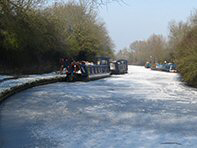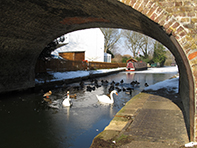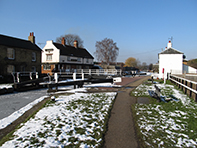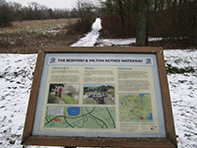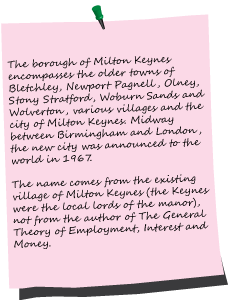
Soulbury to Milton Keynes
Boats gather near bridge 106 but the canal is untroubled until Stoke Hammond Lock where there are a few more craft and practically the only noise is from water cascading from the lock. All good things come to an end as the canal hits a B road and, soon after bridge 102, reaches Willowbridge Marina before going under the A4146.
And then Bletchley appears. Rows of identikit homes, luckily shielded by trees. Once its own town, Bletchley has now been swallowed up by Milton Keynes. You do pass some more attractive houses and then bungalows with great views after bridge 98, where the canal is high above the surrounding land. Then, after two allotments, it is again surprisingly quiet passing close by the Roman settlement of Mogiovinium. Further on there’s a winding hole and a marina near Watling Street with the Bridge Inn above. Then, after passing a new development, there’s Fenny Lock 22 with the Red Lion over a swing bridge.
This was originally a bustling place with wharfs and offices. Built in 1802, the lock is unusual as its purpose was to overcome a leakage problem north of here and to maintain water levels. Therefore the drop is only about a foot, the smallest on the Grand Union, and the canal remains at the same level for the next eleven miles. Fenny Stratford as a place, although with a long history, is unremarkable. From a marshy ford in roman times it has now also been submerged in the Milton Keynes gloop.
Passing the visitor moorings the towpath becomes single file for practically the first time. There is an increasingly barren urban feel, exaggerated by the concrete road bridges, even though there is open parkland on the right. After passing under the A5, houses begin to encroach and everywhere is the sound of traffic. A line of boats welcomes you to The Plough and, after bridge 90C, the towpath is metalled for a while again along a line of poplar trees. Buildings come and go but the traffic noise is always present. After reaching Milton Keynes Marina, boats are moored until past bridge 88.
The mixture of housing on the left and parkland on the right continues, although the architect of the former possibly honed his skills on prison buildings before winning this commission. Subsequently the housing improves and seems to have been designed professionally. Perhaps this is a great modern place to live. If a well planned, in a logical way, city with good transport and facilities was the objective who can say it’s not a success. To judge it aesthetically is subjective, most people just want their bus to arrive on time.
After Chaffron Way the towpath is grassed over and there is a parallel cycling route used by joggers and dog walkers who noticeably haven’t got around to buying pooper scoopers. At bridge 82A there is a notice board explaining the proposed Bedford & Milton Keynes Waterway. Some of the worst traffic noise is left behind now as the canal bends sharply at bridge 81B, although the respite doesn’t last long as houses return to both sides. The surrounding area is well landscaped and there are weeping willows in front of new houses. You are however never far away from very large road bridges like 79A before the Lionhearts Cruising Club.
Then the mood changes becoming transiently countrified before football pitches kick in on the left and high density housing on the right. The Giffard Park pub offers sizzlers if you hadn’t already filled up at the vegetarian café signposted from bridge 81. The relatively short lived 1¼ mile Newport Pagnell branch left the mainline at the next winding hole at Linford Wharf but has now largely disappeared. The towpath is now newly laid and easy but passing Great Linford without a look would mean missing out on an attractive village with a 12th century church and manor house. Moving on there are few boats cruising the rural landscape before the Black Horse Inn and moorings, then fresh new housing appears high on the horizon like Zulu warriors and will no doubt in the future take up all the open land between it and the canal.
It feels as though you are about to head out into the country but the houses just won’t go away. The canal also has other ideas when it swings around Target Turn to reach the heavily tattooed bridge 74. This is New Bradwell and the New Inn stands next to bridge 72. The town isn’t old, growing up in the railway age with Wolverton, and suffering bombing damage in the last war possibly because of the other town’s proximity.
And then Bletchley appears. Rows of identikit homes, luckily shielded by trees. Once its own town, Bletchley has now been swallowed up by Milton Keynes. You do pass some more attractive houses and then bungalows with great views after bridge 98, where the canal is high above the surrounding land. Then, after two allotments, it is again surprisingly quiet passing close by the Roman settlement of Mogiovinium. Further on there’s a winding hole and a marina near Watling Street with the Bridge Inn above. Then, after passing a new development, there’s Fenny Lock 22 with the Red Lion over a swing bridge.
This was originally a bustling place with wharfs and offices. Built in 1802, the lock is unusual as its purpose was to overcome a leakage problem north of here and to maintain water levels. Therefore the drop is only about a foot, the smallest on the Grand Union, and the canal remains at the same level for the next eleven miles. Fenny Stratford as a place, although with a long history, is unremarkable. From a marshy ford in roman times it has now also been submerged in the Milton Keynes gloop.
Passing the visitor moorings the towpath becomes single file for practically the first time. There is an increasingly barren urban feel, exaggerated by the concrete road bridges, even though there is open parkland on the right. After passing under the A5, houses begin to encroach and everywhere is the sound of traffic. A line of boats welcomes you to The Plough and, after bridge 90C, the towpath is metalled for a while again along a line of poplar trees. Buildings come and go but the traffic noise is always present. After reaching Milton Keynes Marina, boats are moored until past bridge 88.
The mixture of housing on the left and parkland on the right continues, although the architect of the former possibly honed his skills on prison buildings before winning this commission. Subsequently the housing improves and seems to have been designed professionally. Perhaps this is a great modern place to live. If a well planned, in a logical way, city with good transport and facilities was the objective who can say it’s not a success. To judge it aesthetically is subjective, most people just want their bus to arrive on time.
After Chaffron Way the towpath is grassed over and there is a parallel cycling route used by joggers and dog walkers who noticeably haven’t got around to buying pooper scoopers. At bridge 82A there is a notice board explaining the proposed Bedford & Milton Keynes Waterway. Some of the worst traffic noise is left behind now as the canal bends sharply at bridge 81B, although the respite doesn’t last long as houses return to both sides. The surrounding area is well landscaped and there are weeping willows in front of new houses. You are however never far away from very large road bridges like 79A before the Lionhearts Cruising Club.
Then the mood changes becoming transiently countrified before football pitches kick in on the left and high density housing on the right. The Giffard Park pub offers sizzlers if you hadn’t already filled up at the vegetarian café signposted from bridge 81. The relatively short lived 1¼ mile Newport Pagnell branch left the mainline at the next winding hole at Linford Wharf but has now largely disappeared. The towpath is now newly laid and easy but passing Great Linford without a look would mean missing out on an attractive village with a 12th century church and manor house. Moving on there are few boats cruising the rural landscape before the Black Horse Inn and moorings, then fresh new housing appears high on the horizon like Zulu warriors and will no doubt in the future take up all the open land between it and the canal.
It feels as though you are about to head out into the country but the houses just won’t go away. The canal also has other ideas when it swings around Target Turn to reach the heavily tattooed bridge 74. This is New Bradwell and the New Inn stands next to bridge 72. The town isn’t old, growing up in the railway age with Wolverton, and suffering bombing damage in the last war possibly because of the other town’s proximity.

Hover over bold italic text for more information
